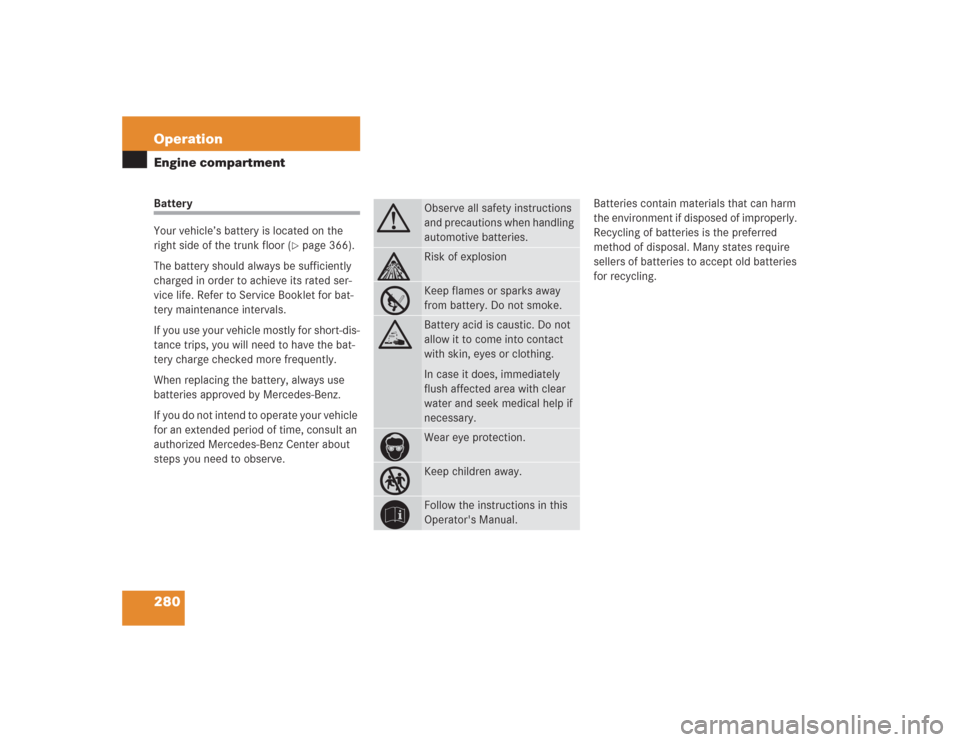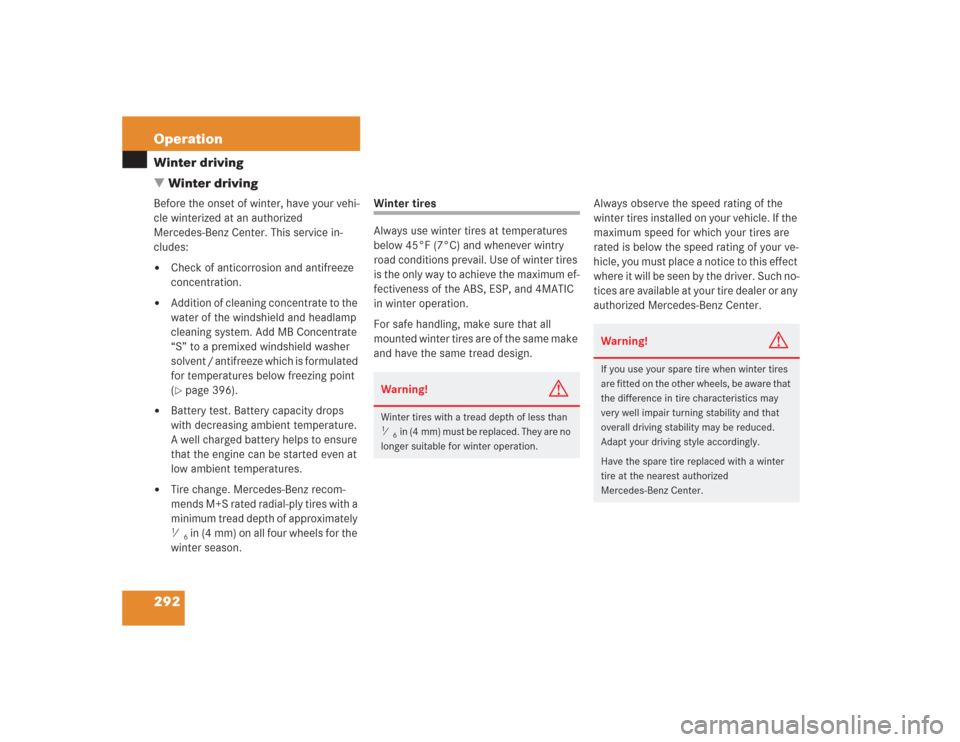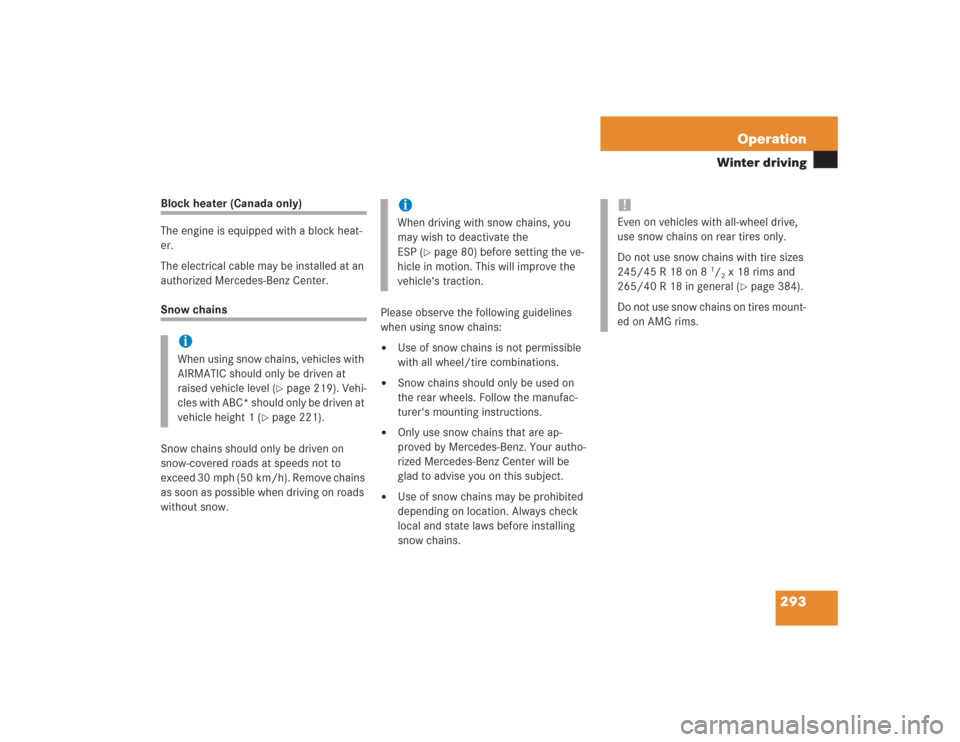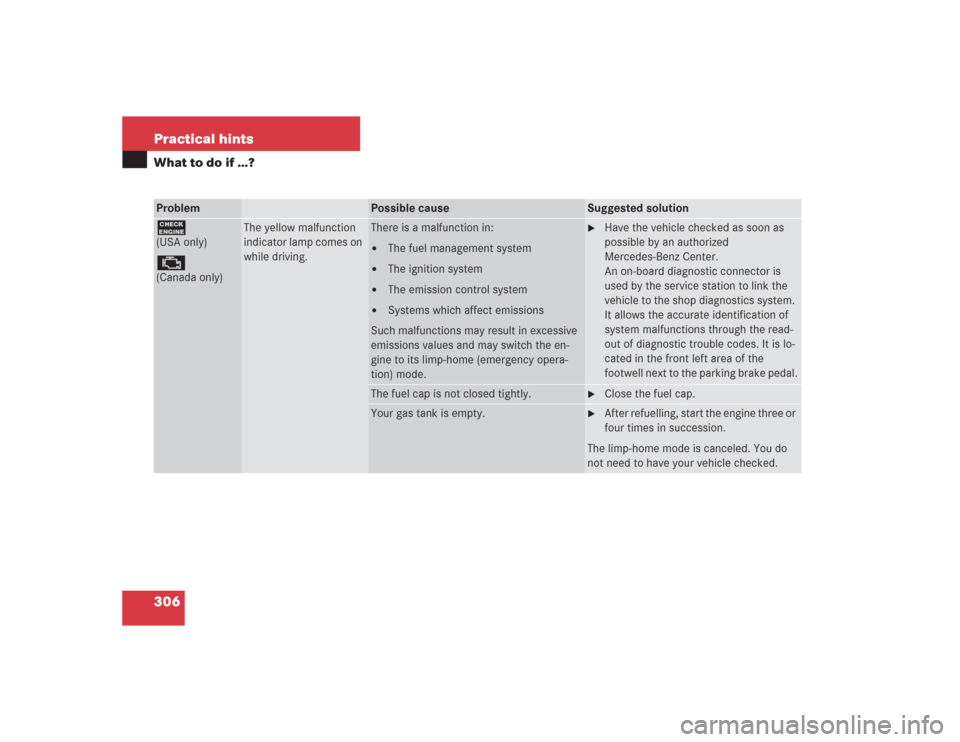Page 279 of 435

278 OperationEngine compartmentBe careful not to spill any oil when adding.
Avoid environmental damage caused by oil
entering the ground or water.�
Screw filler cap1 back on filler neck.
For more information on engine, see the
“Technical data” section (
�page 391) and
(
�page 393).
Transmission fluid level
The transmission fluid level does not need
to be checked. If you notice transmission
fluid loss or gear shifting malfunctions,
have an authorized Mercedes-Benz Center
check the automatic transmission.Active Body Control* (ABC*) fluid level
Regular fluid level check is not required. If
you notice fluid leaks or malfunction mes-
sages in the multifunction display, have an
authorized Mercedes-Benz Center check
the ABC-system.
Coolant
The engine coolant is a mixture of water
and anticorrosion/antifreeze.
When checking the coolant level, �
the vehicle must be parked on level
ground, and
�
the engine must be cool.
!Excess oil must be siphoned or drained
off. It could cause damage to the en-
gine and catalytic converter not cov-
ered by the Mercedes-Benz Limited
Warranty.
��
Page 281 of 435

280 OperationEngine compartmentBattery
Your vehicle’s battery is located on the
right side of the trunk floor (
�page 366).
The battery should always be sufficiently
charged in order to achieve its rated ser-
vice life. Refer to Service Booklet for bat-
tery maintenance intervals.
If you use your vehicle mostly for short-dis-
tance trips, you will need to have the bat-
tery charge checked more frequently.
When replacing the battery, always use
batteries approved by Mercedes-Benz.
If you do not intend to operate your vehicle
for an extended period of time, consult an
authorized Mercedes-Benz Center about
steps you need to observe.Batteries contain materials that can harm
the environment if disposed of improperly.
Recycling of batteries is the preferred
method of disposal. Many states require
sellers of batteries to accept old batteries
for recycling.
G
Observe all safety instructions
and precautions when handling
automotive batteries.
A
Risk of explosion
D
Keep flames or sparks away
from battery. Do not smoke.
B
Battery acid is caustic. Do not
allow it to come into contact
with skin, eyes or clothing.
In case it does, immediately
flush affected area with clear
water and seek medical help if
necessary.
E
Wear eye protection.
C
Keep children away.
F
Follow the instructions in this
Operator's Manual.
Page 293 of 435

292 OperationWinter driving
�Winter drivingBefore the onset of winter, have your vehi-
cle winterized at an authorized
Mercedes-Benz Center. This service in-
cludes:�
Check of anticorrosion and antifreeze
concentration.
�
Addition of cleaning concentrate to the
water of the windshield and headlamp
cleaning system. Add MB Concentrate
“S” to a premixed windshield washer
solvent / antifreeze which is formulated
for temperatures below freezing point
(�page 396).
�
Battery test. Battery capacity drops
with decreasing ambient temperature.
A well charged battery helps to ensure
that the engine can be started even at
low ambient temperatures.
�
Tire change. Mercedes-Benz recom-
mends M+S rated radial-ply tires with a
minimum tread depth of approximately 1⁄6 in (4 mm) on all four wheels for the
winter season.
Winter tires
Always use winter tires at temperatures
below 45°F (7°C) and whenever wintry
road conditions prevail. Use of winter tires
is the only way to achieve the maximum ef-
fectiveness of the ABS, ESP, and 4MATIC
in winter operation.
For safe handling, make sure that all
mounted winter tires are of the same make
and have the same tread design.Always observe the speed rating of the
winter tires installed on your vehicle. If the
maximum speed for which your tires are
rated is below the speed rating of your ve-
hicle, you must place a notice to this effect
where it will be seen by the driver. Such no-
tices are available at your tire dealer or any
authorized Mercedes-Benz Center.Warning!
G
Winter tires with a tread depth of less than 1⁄6in (4 mm) must be replaced. They are no
longer suitable for winter operation.
Warning!
G
If you use your spare tire when winter tires
are fitted on the other wheels, be aware that
the difference in tire characteristics may
very well impair turning stability and that
overall driving stability may be reduced.
Adapt your driving style accordingly.
Have the spare tire replaced with a winter
tire at the nearest authorized
Mercedes-Benz Center.
Page 294 of 435

293 Operation
Winter driving
Block heater (Canada only)
The engine is equipped with a block heat-
er.
The electrical cable may be installed at an
authorized Mercedes-Benz Center.Snow chains
Snow chains should only be driven on
snow-covered roads at speeds not to
exceed 30 mph (50 km/h). Remove chains
as soon as possible when driving on roads
without snow.Please observe the following guidelines
when using snow chains:
�
Use of snow chains is not permissible
with all wheel/tire combinations.
�
Snow chains should only be used on
the rear wheels. Follow the manufac-
turer's mounting instructions.
�
Only use snow chains that are ap-
proved by Mercedes-Benz. Your autho-
rized Mercedes-Benz Center will be
glad to advise you on this subject.
�
Use of snow chains may be prohibited
depending on location. Always check
local and state laws before installing
snow chains.
iWhen using snow chains, vehicles with
AIRMATIC should only be driven at
raised vehicle level (
�page 219). Vehi-
cles with ABC* should only be driven at
vehicle height 1 (
�page 221).
iWhen driving with snow chains, you
may wish to deactivate the
ESP (
�page 80) before setting the ve-
hicle in motion. This will improve the
vehicle‘s traction.
!Even on vehicles with all-wheel drive,
use snow chains on rear tires only.
Do not use snow chains with tire sizes
245/45 R 18 on 8
1/2 x 18 rims and
265/40 R 18 in general (
�page 384).
Do not use snow chains on tires mount-
ed on AMG rims.
Page 307 of 435

306 Practical hintsWhat to do if …?Problem
Possible cause
Suggested solution
?(USA only)±(Canada only)
The yellow malfunction
indicator lamp comes on
while driving.
There is a malfunction in:�
The fuel management system
�
The ignition system
�
The emission control system
�
Systems which affect emissions
Such malfunctions may result in excessive
emissions values and may switch the en-
gine to its limp-home (emergency opera-
tion) mode.
�
Have the vehicle checked as soon as
possible by an authorized
Mercedes-Benz Center.
An on-board diagnostic connector is
used by the service station to link the
vehicle to the shop diagnostics system.
It allows the accurate identification of
system malfunctions through the read-
out of diagnostic trouble codes. It is lo-
cated in the front left area of the
footwell next to the parking brake pedal.
The fuel cap is not closed tightly.
�
Close the fuel cap.
Your gas tank is empty.
�
After refuelling, start the engine three or
four times in succession.
The limp-home mode is canceled. You do
not need to have your vehicle checked.
Page 309 of 435
308 Practical hintsWhat to do if …?Problem
Possible cause
Suggested solution
v
The yellow ESP warning lamp
comes on while driving.
The ESP is deactivated.
Risk of accident!
Adapt your speed and driving to the prevail-
ing road, weather, and traffic conditions.
�
Switch the ESP back on (
�page 81).
If the ESP cannot be switched back on, have
the system checked at an authorized
Mercedes-Benz Center as soon as possible.
The yellow fuel tank reserve
warning lamp comes on while
driving.
The fuel level has gone below the reserve
mark.
�
Refuel at the next gas station
(�page 269).
<
The red seat belt telltale illumi-
nates for a brief period after
starting the engine.
The warning lamp reminds you to fasten
seat belts.
�
Fasten your seat belt.
The warning lamp goes out.
Page 317 of 435
316 Practical hintsWhat to do if …?Display
Display message
Possible cause
Possible solution
ESP
NOT AVAILABLE!
SEE OPER. MANUAL
The ESP was deactivated the power supply
has been interrupted.
The ABS is still operational.
�
Synchronize the ESP. With the vehicle sta-
tionary and the engine running, turn the
steering wheel completely to the left and
then to the right to synchronize the ESP.
If the ESP message does not go out:
�
Continue driving with added caution.
�
Have the system checked at an authorized
Mercedes-Benz Center as soon as possible.
Failure to follow these instructions increases the
risk of an accident.
!When synchronizing the ESP, make
sure you can turn the steering wheel in
both directions as far as it will go with-
out the wheel hitting any objects, e.g.
aroad curb.
Page 321 of 435
320 Practical hintsWhat to do if …?Display symbol
Display message
Possible cause
Possible solution
#
BATTERY/ALTERNATOR
VISIT WORKSHOP!
The battery was charged with a battery
charger or jump started.
�
Have the battery checked at a service
station.
The battery is no longer charging.
Possible causes:�
alternator malfunctioning
�
broken poly-V-belt
�
Stop immediately and check the
poly-V-belt.
If it is broken:
�
Do not continue to drive. Otherwise the
engine will overheat due to an inoperative
water pump which may result in damage
to the engine. Notify an authorized
Mercedes-Benz Center.
If it is intact:
�
Drive immediately to the nearest autho-
rized Mercedes-Benz Center. Adjust driv-
ing to be consistent with reduced braking
responsiveness.